The feeding habits of mother birds are fascinating and complex, as they play a crucial role in ensuring the survival and growth of their offspring. From regurgitation feeding to monitoring nestling nutrition, there are numerous techniques that avian parents use to provide for their babies.
Understanding these feeding strategies is vital for researchers seeking to study avian parenting behavior, as well as bird enthusiasts who are interested in learning more about these remarkable creatures.
Table of Contents
- 1 Key Takeaways:
- 2 How Do Mother Birds Feed Their Babies?
- 3 Parental Feeding Strategies in Avian Species
- 4 Feeding Habits of Mother Birds in the Wild
- 5 Regurgitation Feeding: A Common Technique
- 6 The Role of Feeding Behavior in Avian Parents
- 7 The Importance of Maternal Care in Birds
- 8 Maternal Instincts: A Driving Force in Bird Parenting
- 9 Monitoring Nestling Nutrition
- 10 Environmental Factors Impacting Parental Provisioning
- 11 Challenges Faced by Mother Birds in Feeding Their Babies
- 12 Adaptations for Successful Parental Feeding
- 13 Understanding the Intricacies of Mother Bird Feeding Habits
- 14 Conclusion
- 15 FAQs: How Do Mother Birds Feed Their Babies?
- 15.1 What types of food do mother birds provide to their babies?
- 15.2 How do mother birds find food for their babies?
- 15.3 How often do mother birds feed their babies?
- 15.4 What happens if a mother bird cannot find enough food for her babies?
- 15.5 How long do mother birds continue to feed their babies?
- 15.6 Do all bird species use regurgitation feeding?
- 15.7 How do mother birds assess the nutritional needs of their babies?
- 15.8 What are some challenges faced by mother birds in feeding their babies?
- 15.9 How do environmental factors impact the feeding behavior of mother birds?
- 16 Author
Key Takeaways:
- Mother birds employ various feeding strategies to ensure proper nutrition for their offspring.
- Regurgitation feeding is a common technique used by many bird species.
- Environmental factors can impact maternal provisioning and feeding behavior.
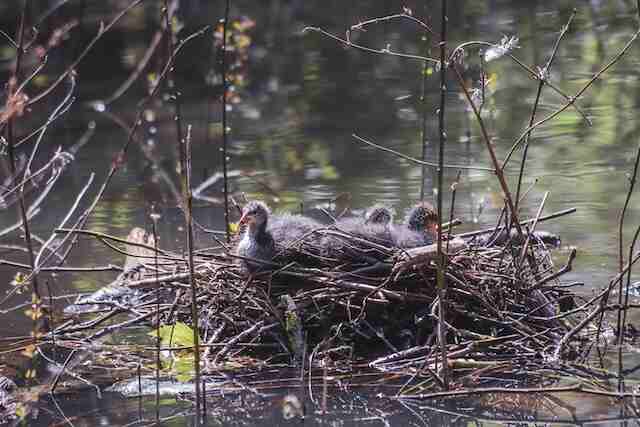
How Do Mother Birds Feed Their Babies?
Mother birds feed their babies through regurgitation. They partially digest food, then bring it up to chicks’ mouths. Parents provide frequent feedings, varying the diet with insects, worms, and more. As chicks grow, they transition to self-feeding while parents guide. Both parents often share feeding duties.
Parental Feeding Strategies in Avian Species
Avian nestling nutrition is crucial for the survival and proper development of baby birds. This is why mother birds employ different feeding strategies to ensure that their offspring are receiving the necessary nutrients for growth.
Types of Food Provided
Mother birds offer a variety of food to their babies, depending on the species and the environment in which they are found. These can include insects, seeds, fruits, and small animals such as worms or rodents. Some birds, like raptors, provide their young with freshly caught prey.
In species where both parents are involved in chick rearing, each may have a different role. For example, the male may focus on capturing prey and bringing it back to the nest, while the female is responsible for feeding the babies.
Regurgitation Feeding
One of the most common feeding techniques used by mother birds is regurgitation. This involves the adult bird regurgitating partially digested food and feeding it to their chicks. Regurgitation allows young birds to receive a nutrient-rich meal that is easy to digest and has been pre-processed by the adult’s digestive system.
In some species, both parents will regurgitate food for the young. In others, only the female will do so. In some cases, if food is scarce, the larger or more dominant chicks may receive a greater share of regurgitated food, to the detriment of their smaller siblings.
Importance of Nestling Nutrition
Proper nutrition is essential for the growth and development of nestling birds. This is why avian parents pay close attention to the nutritional needs of their offspring. Inadequate or inappropriate food can lead to stunted growth, developmental issues, or even death.
To ensure that their chicks receive the proper nutrients, parent birds may adjust their feeding behaviors based on factors such as the age and size of the chicks, the nutritional content of available food, and the weather conditions. Some species may even supplement their chicks’ diets with calcium or other minerals to aid in bone development.
Understanding the feeding strategies employed by mother birds can give insight into the complexities of avian parenting. By monitoring and providing proper nutrition to their offspring, these feathered parents ensure the survival and success of their young.
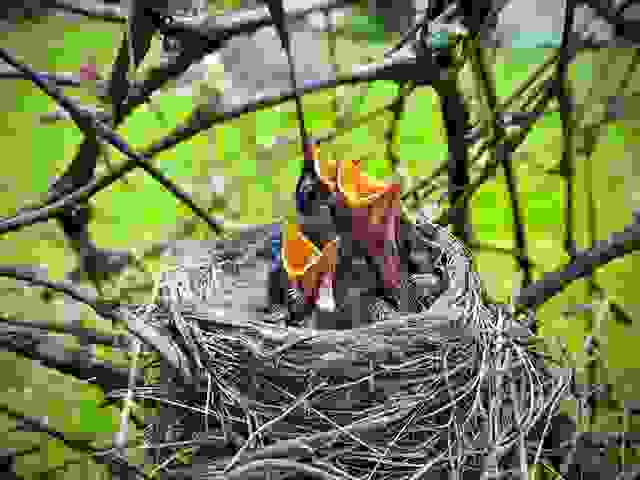
Feeding Habits of Mother Birds in the Wild
Feeding habits of mother birds in the wild play a crucial role in their survival and that of their offspring. Birds have a diverse range of feeding habits, which are shaped by their type of beak, body size, habitat, and the type of prey available.
For example, birds that hunt for insects or small prey, such as warblers or sparrows, use a technique called “gleaning,” whereby they search for insects and larvae hiding in leaves, bark, and other protected areas. Others, such as hawks and eagles, use their sharp talons to catch and kill larger prey, such as rodents and other birds.
Once the prey has been captured, mother birds bring it back to their nest to feed their babies. Depending on the species, mother birds may feed their nestlings a variety of food, including insects, seeds, fruits, nectar, or even small vertebrates. They usually feed their babies small portions of food throughout the day to ensure optimum nutrition and growth.
Examples of Feeding Habits
| Bird | Feeding Habit |
|---|---|
| Woodpeckers | Drill into trees to extract insects and larvae |
| Hummingbirds | Feed on nectar from flowers |
| Pelicans | Scoop up fish and water using their beaks |
| Ospreys | Dive into water to catch fish |
In some species, both the male and female share in the feeding duties, while in others, only the female takes on this responsibility. Some species, such as cuckoos, do not feed their young at all but lay their eggs in the nests of other birds, leaving their offspring to be raised by foster parents.
Regardless of the specific feeding habits, maternal care in bird species is a complex process, which involves a variety of factors, including environmental conditions, food availability, and the specific needs of their offspring.
Regurgitation Feeding: A Common Technique
One of the most common feeding techniques used by mother birds is regurgitation. This is where the parent bird brings food back up from their stomach and feeds it directly to their nestlings.
Regurgitation feeding is unique to birds and is an important part of avian parenting. It allows the mother bird to provide her offspring with a constant source of food, ensuring they receive the necessary nutrients to grow and develop.
Regurgitated food is often pre-digested, making it easier for the baby birds to consume and digest. Parent birds typically regurgitate a mixture of insects, seeds, and small animals, depending on the species and the availability of food.
While regurgitation feeding is an efficient way to provide for offspring, it can also have its drawbacks. For example, if the parent bird is not eating a balanced diet or is exposed to toxins, these can be passed on to the nestlings through regurgitated food.
Despite these potential risks, regurgitation feeding remains an essential part of avian parental care. It allows mother birds to provide for their babies in a way that is unique to their species and has played a crucial role in the evolution of birds as a whole.
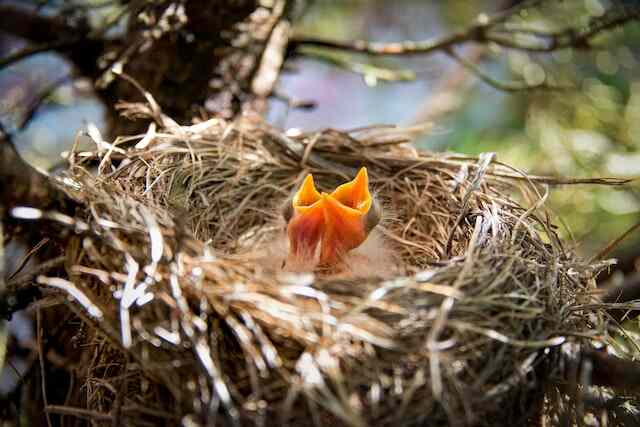
The Role of Feeding Behavior in Avian Parents
Feeding behavior plays a crucial role in the parental care of avian species. The decisions made by parents regarding what and how much to feed their offspring can have significant impacts on the survival and growth of their babies.
- Prey availability is one of the most critical factors influencing avian feeding behavior. If food is scarce, parents may need to adjust their feeding strategies to ensure that their nestlings receive enough nutrition.
- Environmental conditions, such as weather patterns and temperature, can also influence feeding behavior. High temperatures, for example, can increase the need for water and affect the availability of prey.
- The specific needs of the offspring also play a significant role in feeding decisions. Newborn birds, for example, require more frequent feedings and smaller food items than older, more developed offspring.
Mother birds often display remarkable flexibility in their feeding behavior, adjusting their strategies as needed to provide for their offspring under varying conditions.
“Feeding behavior plays a crucial role in the parental care of avian species.”
The Importance of Maternal Care in Birds
Maternal care is a crucial aspect of avian parenting, particularly when it comes to feeding their babies. Mother birds go to great lengths to ensure that their offspring receive the proper nutrition for their growth and survival.
From providing regurgitated meals to hunting for prey, these birds have a variety of feeding techniques at their disposal to meet their nestlings’ needs.
The nutrition provided by mother birds has a significant impact on the development of their offspring.
Adequate nutrition is essential for proper growth, immunity, and cognitive development in the early stages of life. As a result, maternal care plays a crucial role in shaping the future of bird populations.
Maternal Instincts: A Driving Force in Bird Parenting
The driving force behind the maternal care exhibited by bird parents is their innate maternal instincts. These instincts have evolved over time to ensure the survival and growth of their offspring.
When it comes to feeding their babies, mother birds display a variety of behaviors that are guided by their maternal instincts. They actively search for food, select appropriate prey, and use regurgitation to provide their offspring with the necessary nutrition.
Studies have shown that maternal instincts lead to better feeding practices in avian parents. This is because these instincts drive mothers to prioritize the nutritional needs of their babies over their own. They monitor their offspring’s nutritional status and adjust their feeding practices accordingly.
“Maternal instincts have evolved over time to ensure the survival and growth of offspring.”
Maternal instincts also play a key role in protecting bird offspring from predators. Mother birds exhibit aggressive behaviors towards potential threats, such as swooping down on predators or distracting them from the nest. These behaviors are driven by the instinct to protect their babies from harm.
Overall, it is clear that maternal instincts are a driving force in avian parenting. They guide feeding behaviors, protect offspring, and ensure the overall well-being of bird offspring.
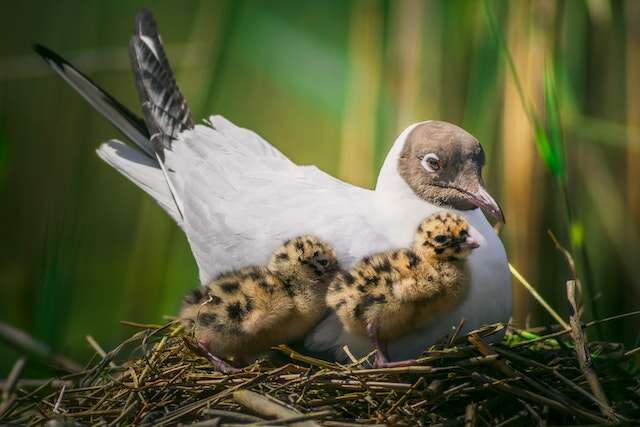
Monitoring Nestling Nutrition
Mother birds play an integral role in ensuring the proper nutrition and growth of their offspring. As such, they often monitor the nestling’s nutritional intake to assess their health and development.
One common method used by mother birds to monitor nestling nutrition is through direct observation. They observe their chicks to gauge their weight gain, behavior, and overall health. If they notice any signs of malnourishment or sickness, they will increase their feeding efforts to ensure their babies receive enough food.
Another method to monitor nestling nutrition is through the frequency of feedings. Studies have shown that the more frequently mother birds feed their offspring, the greater the chance of survival and growth.
By keeping track of how often they are feeding their nestlings, avian parents can ensure their chicks are receiving enough nutrients for proper development.
Finally, mother birds may also assess the appearance and quality of their offspring’s feathers and general condition.
Poor feather quality or slow development can indicate a lack of proper nutrition, prompting the mother bird to adjust their feeding habits.
Environmental Factors Impacting Parental Provisioning
Mother birds face numerous challenges when it comes to feeding their offspring, and environmental factors can greatly impact their ability to provide for their babies. Changes in habitat, food availability, and climate can all influence the feeding behavior of mother birds, and their ability to meet the nutritional needs of their offspring.
One of the primary environmental factors that can impact parental provisioning is habitat loss. As natural habitats are destroyed or altered, the food sources that mother birds rely on may become scarce or inaccessible, making it more difficult for them to find enough food to feed their babies.
Another factor is competition for food. In areas where food is limited or highly sought after, mother birds may have to compete with other species or members of their own species for resources. This competition can make it harder for them to find enough food to provide for their offspring.
Climate can also play a role in parental provisioning. Changes in weather patterns or extreme weather events can impact food availability, making it more difficult for mother birds to find enough food to feed their babies. In addition, changes in temperature or precipitation can impact the nutritional value of the food sources that mother birds rely on.
Understanding the environmental factors that impact parental provisioning is essential for researchers and conservationists working to protect bird populations. By identifying and addressing these factors, we can help ensure that mother birds have the resources they need to successfully raise their offspring.
Challenges Faced by Mother Birds in Feeding Their Babies
Feeding nestlings is a challenging task for mother birds, as they must balance their own nutritional needs with those of their offspring. In addition, they face several other challenges while feeding their babies.
- Predation: Predators pose a significant risk to both mother birds and their nestlings. Foraging for food can make them vulnerable to attacks from animals such as snakes, raccoons, and squirrels.
- Competition for Food: Food scarcity can put pressure on mother birds to compete for resources with other animals, including members of their own species. This competition can lead to reduced food availability and increased energy expenditure for the mother bird.
- Demanding Offspring: Raising multiple offspring at once can be a significant challenge for mother birds. Larger broods may require more food, which can place additional strain on the mother’s energy reserves.
Despite these challenges, mother birds have evolved a variety of strategies to overcome them and ensure the survival of their offspring.
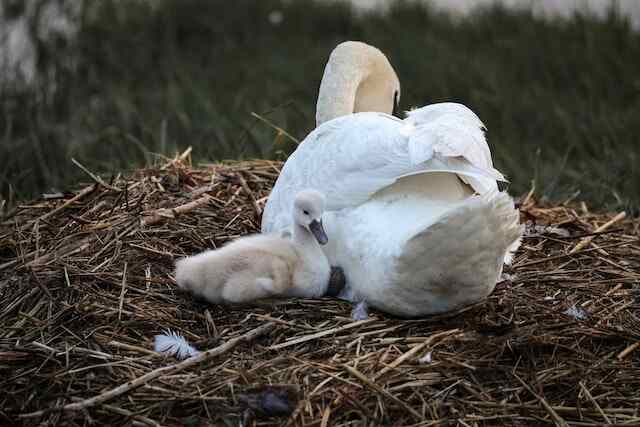
Adaptations for Successful Parental Feeding
Mother birds have evolved and developed several adaptations throughout their evolutionary journey to ensure successful parental feeding. These adaptations allow them to obtain food, transport it, and deliver it to their nestlings.
One of the most remarkable adaptations is the beak, which varies in shape and size among different avian species. For example, the long and thin beaks of hummingbirds enable them to reach deep into flowers to extract nectar, while the sharp-pointed beaks of raptors allow them to tear apart prey.
Another adaptation is the crop, a muscular pouch in the esophagus of birds that allows them to store food before it is digested. This adaptation is particularly useful for species that feed on seeds or insects, as it enables them to store food and feed their young later.
Additionally, many bird species practice brood reduction, which is the process of sacrificing weaker offspring in favor of stronger ones. This adaptation ensures that the stronger nestlings receive all the necessary resources from their parents, increasing their chances of survival.
Finally, many bird species exhibit foraging strategies that aid in successful feeding. For example, some birds, such as woodpeckers, are specialized in finding hidden insects within tree bark. Other birds have adapted to feeding on fruits or nectar, which are easier to obtain and require less energy expenditure.
Understanding the Intricacies of Mother Bird Feeding Habits
As we have seen, mother birds use a variety of techniques to ensure their offspring receive proper nutrition. From regurgitation to hunting, birds have evolved unique parenting strategies that allow them to provide for their babies in the wild.
Understanding these feeding habits is crucial for researchers studying avian parenting, bird enthusiasts observing nesting behavior, and anyone interested in the intricacies of the natural world.
By examining the factors that influence maternal care, studying the adaptations that aid in successful feeding, and assessing the challenges that mother birds face, we can gain a more thorough understanding of avian survival strategies and the beauty of the natural world.
Conclusion
In conclusion, the process of how mother birds feed their babies is a remarkable testament to the intricate balance of nature. Through regurgitation and attentive care, parent birds provide their young with vital nourishment, ensuring their growth and development.
The close bond between parent and chick is evident in the careful provisioning, the gradual transition to self-feeding, and the shared responsibilities of both parents.
As we marvel at the diverse strategies employed by different bird species, we gain a deeper appreciation for the resilience and resourcefulness of avian life.
The nurturing efforts of mother birds remind us of the interconnectedness of all living beings and the importance of safeguarding their habitats for generations to come.
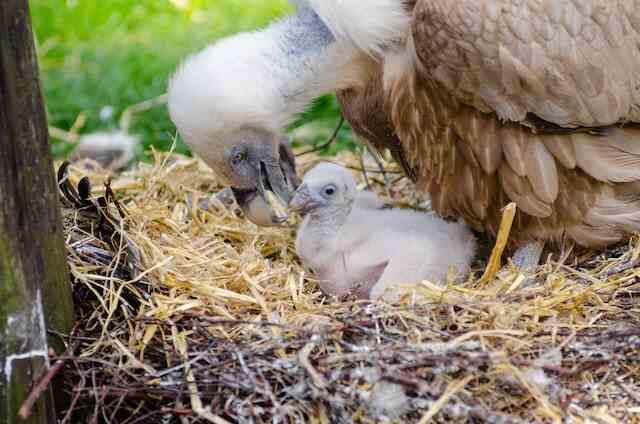
FAQs: How Do Mother Birds Feed Their Babies?
What types of food do mother birds provide to their babies?
Mother birds provide a variety of food to their babies, including regurgitated meals and captured prey. The specific types of food depend on the species of bird and their natural diet.
How do mother birds find food for their babies?
Mother birds search for food by using their keen eyesight and hearing to locate prey. They may also rely on their knowledge of local food sources and the availability of food in their surroundings.
How often do mother birds feed their babies?
The frequency of feeding varies depending on factors such as the age of the babies and the species of bird. In general, mother birds feed their babies multiple times per day to ensure they receive sufficient nutrition.
What happens if a mother bird cannot find enough food for her babies?
If a mother bird struggles to find enough food for her babies, it can have negative consequences for the offspring. In some cases, the babies may not receive enough nutrition, which can lead to stunted growth or even mortality.
How long do mother birds continue to feed their babies?
The duration of parental feeding varies depending on the species of bird. Some mother birds continue to feed their babies until they are able to fly and fend for themselves, while others may stop feeding them earlier in the fledgling stage.
Do all bird species use regurgitation feeding?
No, not all bird species use regurgitation feeding as their primary feeding method. While regurgitation feeding is common in many bird species, others may employ different strategies, such as placing food directly in the mouths of their offspring.
How do mother birds assess the nutritional needs of their babies?
Mother birds monitor the growth and development of their babies to assess their nutritional needs. They may observe their offspring’s behavior and physical appearance to determine if they need to adjust their feeding behavior.
What are some challenges faced by mother birds in feeding their babies?
Mother birds face various challenges in feeding their babies, including competition for food, predation risks, and the demands of raising multiple offspring simultaneously. These challenges can impact the ability of mother birds to provide sufficient nutrition to their babies.
How do environmental factors impact the feeding behavior of mother birds?
Environmental factors, such as changes in habitat, food availability, and climate, can influence the feeding behavior of mother birds. They may need to adapt their feeding strategies based on the resources and conditions available in their environment.



